

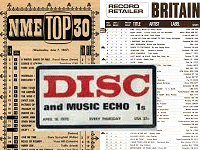
 |

|
 |
|
The
British Music Charts
- A History and Time Line
|
| Music Chart History What a confusing place the British music charts of the Fifties and Sixties were - the jury is still out on the definitive artist and group 'chart performances' of the decade and may never return with a final verdict as there were so many listings or compilation charts published. The various charts and statistics presented by Sixties City use several of the major charts of the time as their basis, and the particular chart source used is stated in each section. For this reason there is no real 'right' or 'wrong' so don't rely on any 'facts' or statistics too heavily as definitive answers for 'free beer bets' down the pub.... The New Musical Express chart is now generally accepted and used as the 'definitive' reference source for British music chart statistics from Friday 14th November 1952 until the Record Retailer chart appeared on 10th March 1960 as a Top 50. From 15th February 1969 the BMRB Top 50 singles chart and its successors have been considered to be the 'official' UK music chart listing. Having said that, here is a general run-down on the creation and evolution of the various (major) British music charts up to the end of the Sixties, by which time it had pretty well assumed the form we see today that is acknowledged as the definitive chart for vinyl record (and other media) sales figures. Prior to 78rpm and vinyl record sales being recorded, and continuing for many years afterwards, the success of popular songs was measured by the sales of sheet music that was purchased by both professional and amateur musicians. Charts of various sorts had been appearing in American publications from as early as 1894 in the 'Phonogram' trade paper. The first radio show to present a 'chart' programme was the American 'Your Lucky Strike Hit Parade', which commenced on 20th April 1935. Melody Maker published a chart in 1935 based on 'most popular songs', both sheet music and 78rpm sales, as advised by a number of outlets but not, apparently, backed up with any particular sales statistics. This was more of a 'one-off' than a regular feature and charts only appeared sporadically over the next few years. The concept of compiling a regular combined 'music chart' based on sales is credited to 'Billboard' who published their first such 'chart' on 20th July 1940. The data used was obtained from report forms completed by both stores and radio stations and the record had to be commercially available as a 'single' to be included. Songs were often omitted from such reports when record labels stopped promoting them, usually resulting in a quick fall down the listing and a shorter 'chart life' than actual sales indicated. It should be noted that many US charts took radio 'airplays' into account when compiling their popularity lists, unlike the UK (apart from some pirate radio stations) who used sales-based data only. In 1946 the UK Music Publishers' Association began issuing their own music charts based on sheet music sales and, from Autumn 1948, the UK was able to listen to the first 'Top Twenty countdown' show broadcast by Radio Luxembourg on Sunday evenings that shaped the pattern for all the chart shows that were to follow. |
 |
 |
The first 45 rpm
singles were introduced in America in 1949 and the UK in 1954, but it wasn't
until 1957 that the format became commonly used in the UK and sales did
not exceed those of 78rpm records until 1959. Record 'sales' initially recorded
sales of 78 rpm records, then a mixture of the two (plus 'LP' and 33 1/3
'EP' recordings) until 78s and EPs were phased out. The first 'disc-based'
chart shows began being aired when programme administrator Derek Johnson
passed the NME's chart to DJs at Luxembourg who broadcast a chart rundown
each night. The NME chart was used by Luxembourg from January 1960 to 1967.
Percy Dickins had originally worked in the advertising department of Melody
Maker, a trade paper for professional musicians founded in 1926 by Lawrence
Wright, but the weekly paper took itself too seriously for his liking and,
together with journalist Ray Sonin, he visualised and planned a more youth
and public-oriented pop and show-business publication. At the time, the Musical Express was being published by Beaverbrook Newspapers as a weekly supplement in the Daily Express. With the help of financial backing from entrepreneur Maurice Kinn, Dickins and Sonin bought the publication and re-launched it as the 'New Musical Express' (better known to most as the NME), a stand-alone title in direct opposition to Melody Maker with Sonin as editor and Dickins responsible for advertising and production. Dickins was looking for a gimmick to boost the publication's sales in the circulation 'war' with Melody Maker and came up with the idea (some sources attribute the original idea to Maurice Kinn) of a music sales 'league table' as a reference to a record's success by imitating the American 'Billboard' music-trade paper that compiled and published a weekly music chart based on the physical sales (and other factors) of vinyl record releases. He canvassed contacts at approximately 20 music sales outlets from a 'pool' of 53, finding out which records were selling best and, on Friday 14th November 1952, the first British pop chart was born, using the sales figures for the week ending 8th November. The listing contained 15 entries spanning 12 positions with the very first 'No 1' position being claimed by Al Martino with his recording of 'Here in My Heart'. The 'record hit parade', as it was known, very quickly became an extremely popular feature and, after only a few weeks, its published statistics were being quoted in record company press releases and adverts. It should be noted that the positions on this, and most early charts, were not based on the total sales from all outlets' returns, but by applying a 'scoring system' for places 1 to 10 for each return and adding these scores together. It was quite possible for a record to have more actual total sales than another, but to end up lower in the final chart rating. Also interesting is the date, as Melody Maker was celebrating its 1,000th issue and this was very likely to have been a planned release by NME to divert attention away from that event.
The NME compilation was arguably the most widely available and recognised chart during the early Sixties, having the advantage of additional exposure due to its use by Radio Luxembourg for its Sunday night Top 20 show. It was also the chart used by ABC TV's 'Thank Your Lucky Stars' which was watched by up to 6 million viewers on ITV every week. At their peak, NME used about 150 phoned returns whereas Melody Maker used around 270 to 280 postal returns from its suppliers, collated by Roy Burchill, Jeff Stars, Alf Martin and Mike Benson. I say 'arguably' because the NME originally had a curious practice of putting 'B' sides in its charts and also of splitting some double 'A' sides into two separate entries. For example, Elvis' 'Rock-a-Hula Baby' / 'Can't Help Falling In Love' was the number one for a month in other charts but only achieved two separate top ten entries (at number 2 and number 3) in NME's chart. NME also continued to allow LPs into their charts even after they started publishing a separate album chart. The Record Retailer chart was unique in that it was the only publication that listed most of the Top 50 positions for the whole decade. It utilised a significantly smaller sample size than some rival charts, mainly canvassing independent record shops that had no funding or affiliation with record companies. As lists of which record shops they used for sampling to compile their charts were generally available, some outlets were subject to 'hyping', but with their chart being less widely used than some others, the Record Retailer outlets did not seem to suffer from this as much. |
| Most chart compilers
polled their outlets and acquired sales figures for the previous week on
a Monday for publication on the Thursday or Friday. For some reason, on
two occasions in the Sixties, Record Retailer did not publish a Christmas
/ New Year chart (2nd January 1965 and 31st December 1966) but they did
actually compile the charts for those weeks and supplied them (provisional,
owing to early printing over the Christmas period) to the Record Mirror
who published them for these dates. Because Melody Maker's sample size was
so large, they also omitted to publish charts over the Christmas period
in 1962 and 63, 1967, 68 and 69 as the figures were deemed to be too unreliable
due to the limited number of returns received. Throughout the Sixties, the various different charts vied for public recognition and, being commercial papers, increasing circulation figures, but they all continued to use different source material for their compilations, leading to some historical anomalies. For example, The Beatles' second single 'Please Please Me' was a number one on most charts, but not in Record Retailer. Another anomaly between chart positions on individual weeks was caused by the fact that NME and Disc also used 'advance sales' figures from record companies when compiling their statistics whereas Record Retailer and Melody Maker used only pure 'actual' over the counter sales figures. This had the effect of many more recordings entering the chart in the 'number one' position in NME and Disc than did in the other two. To add to the confusion, The BBC also used its own chart from 1958 - 'The BBC Top 30' - as the basis for its 'Pick of the Pops' radio show that first aired on 4th October 1955 and was transmitted on the Light programme. This chart was itself a compilation of the charts being published by Record Mirror, Melody Maker, New Musical Express and, later, Disc. The Record Retailer chart figures were not included in their early calculations as its chart was published on a different day to the others, but was included in the average from 31st March 1962 when the Record Mirror ceased compiling their own chart. The BBC chart, being an average of all the others, rarely agreed with any of them and the practice of combining them by totalling points gained in the four charts (1 point for a number 1, 2 for a number 2 etc.) was prone to resulting in there frequently being 'tied' positions. It was not particularly rare to have two 'Number 1s' in any given week and, on one occasion, there were actually three of them. This classic example occurred during the last week of August 1968 when the 'Number 1' records were 'I've Gotta Get A Message To You' by The Bee Gees, 'Do It Again' by The Beach Boys and 'This Guy's In Love With You' by Herb Alpert. This strange occurrence was preserved for posterity by actually being televised on the 29th August 'Top of the Pops' show, hosted by Alan 'Fluff' Freeman. By 1965 editor Ray Sonin had retired from the NME and Maurice Kinn sold his own interest in the paper to the International Publishing Corporation (IPC). Percy Dickins, who had by then inaugurated the iconic NME Poll Winners' Concerts, stayed on as one of the few original staff and would continue to personally oversee the compilation of the NME music chart well into the 1960s. 1965 was the year that Woolworths started selling 'chart hits' supplied mainly by EMI and Decca. Prior to this they had only sold 'cover' versions of records, released on their own 'Embassy' label and which were recorded by many unknown artists, usually backed by a group known as 'The Typhoons' and recorded at a studio in New Bond Street. These were often recorded and delivered to shops on the same day as the 'official' record hit the charts. As their main availability was via Woolworths, Embassy records did not really figure in the charts but were excellent productions at a lower price and, therefore, their sales quite possibly affected sales of the 'official' records in some areas. Also, not being restricted by the copyright or licensing issues of the big record companies, they were quite popular with 'pirate' radio stations. The recording company they used was Oriole, which was at the forefront of the introduction of EPs and picture sleeves to the UK market and were also one of the first companies, preceding the likes of Ronco and K-Tel, to produce compilation albums. It wasn't until 1969 that a much more reliable 'official' British chart was compiled, emerging from an alliance between the BBC and Record Retailer. A professional polling organisation, the British Market Research Bureau (BMRB), were commissioned to compile a weekly record chart using sales figures taken from a pool of 500 record shops, more than twice as many as for any previous chart. The resulting new 'Official Top 50' was first published in the week ending 15th February 1969. In passing, it is curious to note that, considering the popularity of 'record charts' in weekly publications, there were hardly any other pure 'national pop chart' TV shows produced outside of Britain, making the BBC's 'Top Of The Pops' programme almost unique in that respect. The only other local contenders were the short-lived 'Disc-a-Dawn' televised in Wales, and ITV's 'The Chart Show'. Also, although interest levels in 'record charts' were fairly high in America and the UK, they seemed to be comparatively low in other countries. France relied mainly on a monthly chart in the teen magazine 'Salut les Copains' (which only included French recordings and excluded anything that wasn't French). In fact, most of Europe seemed to embrace the British charts, which probably explains why so many 'foreign' record sleeves of the time proudly advertised the fact that the record was a 'Top British hit'. Both Radio Luxembourg and most of the various 'pirate' radio stations all used one or other of the 'major' chart versions, but a few used compilations of their own to great popular effect, most notably Radio Caroline's 'Countdown of Sound' and Radio London with its 'Fabulous Forty'.' Big L', as Radio London was known, was financially backed by American Don Pierson and transmitted from the MV Galaxy off the coast of Essex. The 'Fab 40' was calculated from their weekly playlist and was announced each Sunday as a chart based entirely on airplays. This was, to some extent, 'manipulated' by various labels and production companies with a vested interest in getting their own releases played. 'Pirate' radio 'charts' were not, in fact, representative of actual record sales but more of a prediction of what they thought would shortly become popular and were, to some extent, also a 'plug' for certain records on new release and, because of that, were always in advance of actual charts and sometimes wildly inaccurate, containing recordings that never actually featured in the official sales charts. Radio London's 'Fab 40' was, at times, up to six weeks in advance of actual charts and, during their final week in August 1967, contained many records that were not even due for general release until September! According to Radio Caroline DJ Tom Lodge, "The two (Caroline) ships were always separate. I created the charts on whichever ship I was on, mostly from Melody Maker. We made some subtle changes, but not much, mostly from information we would receive from sales and also feedback from the audience. But that was extremely minimal. Melody Maker was our main source. What was happening, chart-wise, on the ship I was not on, I have no idea". |
 |
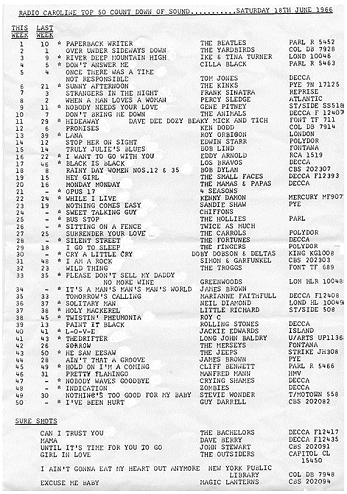 |
Interestingly, during the brief life of 'pirate radio' stations, the Record
Retailer used to publish a report on the comparative chart positions produced
by Radio London, Radio Caroline, Radio City, Radio England, Radio 270 and
Radio Scotland. The BBC had little answer to this until the outlawing of
'pirate' radio broadcasting following which, at 7:00 am on Saturday 30th
September 1967, it launched Radio 1. Until this time dedicated pop music
programmes were very limited although an increasing number of popular records
had been played on the Light programme since 1965, presented by disc jockeys
such as Pete Murray and the weekly Sunday (BBC) Top Twenty 'Pick of the
Pops' programme hosted by Alan 'Fluff' Freeman
between 6 and 7pm. With these new influences on the record-buying public the issue of 'chart rigging' or 'hyping' (the practice of sending out teams of people to buy significant quantities of specific records from sales outlets known to supply chart returns) became the subject of increased concern and, on 15th February 1969, a brand new pop chart appeared which gave very different results from the BBC's previous offerings. The BMRB (British Market Research Bureau) were commissioned, as a result of meetings held between the BBC, the BPI and 'Record Retailer' owners Billboard Publications, to produce a record chart using sales figures from the UK's 6,000+ outlets. Although NME and Melody Maker were invited to join in the discussions they both declined, apparently being content with the accuracy of their own charts. The only drawback to this new chart was that postal returns were used and the sample size was so big that the figures were effectively out of date by the time they were calculated. This did not significantly change until electronic point-of-sale systems were introduced by Gallup in 1983. The new BMRB chart contained only singles, so EPs immediately disappeared from the listings, including entries listed in the previous week's chart. This led to the introduction of the 'maxi-single' that featured one track on the 'A' side and 2 or more tracks on the flip side. EPs were not to figure in the singles charts again until the mid-1970s.
|
 |
Various 'music charts' and listings had been appearing intermittently in America since as early as 1894 in the 'Phonogram' music trade paper Melody Maker publishes a music chart listing 'most popular sales', based on advised popularity of sheet music and 78rpm sales, as part of the 'Song Sheet' page under the title 'Top Tunes' Saturday 4th January - The American music trade paper 'Billboard' publishes its first music 'Hit Parade' Saturday 20th July - Billboard magazine publishes its first regular combined 'music chart' based on record sales and airplays Saturday 27th July - The UK Music Publishers' Association begin issuing their own 'music charts' for the trade, based on sheet music sales Autumn - Radio Luxembourg on 1293m long wave begins broadcasting a 'Top Twenty' show on Sunday evenings hosted by Teddy Johnson, using the MPA sheet music charts Monday 2nd July - English language programmes on Radio Luxembourg move from long wave to 208 metres on medium wave Friday 14th November - NME publishes a Top 12 'music chart' - the 'Record Hit Parade' (actually 15 entries in 12 positions) Saturday 24th October - Attempts are made to avoid the practice of records being 'tied' for position, although this tends to fluctuate a bit during the following 12 months |
NME publishes the first chart dedicated to British artists Saturday 2nd October - the NME chart is increased to include a Top 20 Saturday 22nd January - the Record Mirror Top 10 chart first appears based on postal returns from 24 record stores that were financed by the newspaper and whose details were also published. The precise date of their first 'record chart' listing is unclear as the image on this page shows a chart from 1954 that claims to be a 'record' chart but is probably a sheet music chart Tuesday 4th October - The BBC begins broadcasting its 'Pick of the Pops' programme, initially with random 'chart' songs but soon tightens the format into a formal 'chart show' using a compilation from the charts published by NME, Melody Maker and Record Mirror Saturday 8th October - The Record Mirror chart is increased to a Top 20 Saturday 31st December - The NME Christmas chart is 25 positions long for one week only Saturday 7th April - Melody Maker publishes charts containing a Top 20 single record chart as well as a sheet music sales chart. It is also the first chart to include Northern Ireland in its 19-store sample. They were the only chart to do this until Gallup included the NI market in 1984 Saturday 14th April - The NME chart is increased to a Top 30 (eventually enlarged to a Top 50 on 14th May 1983) April - The British Forces Broadcasting Network starts compiling a Top 20 for use on their radio Top 20 show. This is the first time a 'chart' of UK record only sales is used in radio broadcasting Saturday 28th July - The Record Mirror is now sampling returns from over 60 outlets and publishes the first UK LP album chart containing 5 positions: 1. Frank Sinatra - Songs For Swingin' Lovers 2. Original Cast - Carousel Soundtrack 3. Mel Torme - At The Crescendo 4. Louis Armstrong - At The Crescendo 5. Original Cast - Oklahoma Soundtrack November - NME produces its first LP album chart September - BBC's 'Pick of the Pops', presented by Alan Dell, changes its format to a 'chart' type show using 'Top Tens' from various music papers Saturday 28th September - EMI begin compiling their own chart (until 1978) using an average of the Melody Maker, NME and Record Mirror charts plus sales figures from around 50 retail outlets, with double 'A' side songs listed as separate entries |
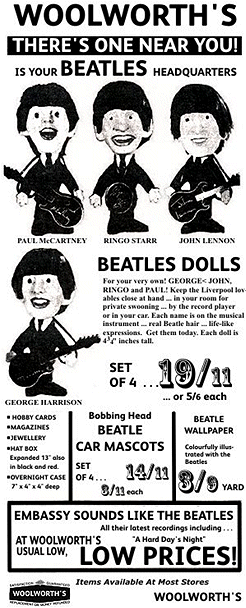 |
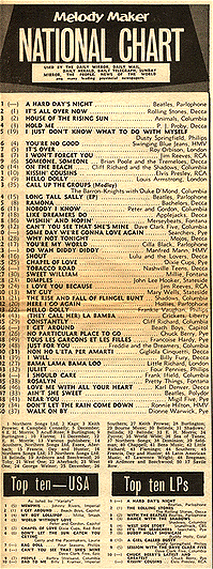 |
January - Record Mail first published Saturday 1st February - 'Disc' (variously known as 'Disc' and 'Disc Weekly' and 'Disc and Music Echo' throughout the 60s) introduces a 'Top 30' singles chart based on a 25-outlet returns pool Saturday 29th March - The BBC starts broadcasting its weekly 'Pick Of The Pops' radio show at 11pm, introduced by David Jacobs, using its own 'compilation' chart - the 'BBC Top 20' Saturday 8th November - Melody Maker introduces a Top 10 LP album chart Tuesday 19th May - Melody Maker introduces a 'Juke Box Top 20' based on plays from about 200 machines around the UK Saturday 27th June to Saturday 8th August - A newspaper industry strike severely affects Record Mirror, Melody Maker and Disc, who are forced to issue their record charts on a specially printed sheet, allowing EMI and the BBC to continue compiling their charts Tuesday 25th August 1959 - Record Retailer is founded by the Gramophone Record Retailers Association as a monthly trade newspaper for labels and dealers. Roy Parker was managing editor Saturday 21st November - Melody Maker publishes the first ever EP chart Radio Luxembourg begin to use the NME chart for its Sunday Top 20 show (until 1966) Thursday 10th March 1960 - Record Retailer changes to a weekly edition (although still not commercially available to the general public) and starts publishing a Top 50 singles chart, also listing an EP chart Top 10. This was obtained from a 30 outlet sampling taken from a pool of 50 and was compiled by Jeremy Wilder, using a 'count back' system to resolve 'tied' positions Thursday 17th March - Record Retailer increases its EP listing to Top 15 Thursday 24th March - Record Retailer increases its EP listing to Top 20 and lists an LP album chart Top 20 Saturday 2nd April - The NME Singles and Album Chart are increased to 50 positions long Saturday 30th July - Melody Maker increases its sampling pool from 60 to 110 (NME are using 80 and Disc about 50) and starts receiving its data by postal returns. It also stops printing information about which stores it is using Saturday 23rd September - Alan 'Fluff' Freeman takes over from long-time presenter David Jacobs on 'Pick of the Pops' in 'Trad Tavern' having fronted the 'new release' show in 1956/7. They were to share the presentation periodically with Don Moss and, later Pete Murray, over the next few years |
|
Sunday 7th January - The BBC's 'Pick of the Pops' moves to a 4pm early evening
Sunday slot, hosted by Alan Freeman Saturday 24th March - The Record Mirror stops compiling its own charts, partly due to prohibitive postal costs in obtaining returns, and publishes Record Retailer's Top 50 chart instead April - NME celebrates its 10th anniversary. Its sales exceed 200,000 copies weekly which is more than all the other sales of weekly 'pop' newspapers combined Saturday 14th April - Melody Maker increases its chart from Top 20 to Top 30 Friday 1st June - NME starts publishing a separate LP chart but continues to include LP sales in its singles chart statistics, a practice that it continues until the late Sixties Saturday 1st September - 'Pop Weekly', formerly 'Top 10 Monthly', is published weekly with a Top 30 chart compiled using a mixture of NME, Melody Maker, Disc and Record Retailer charts, plus returns from about 30 outlets and advance sales figures from record companies Saturday 15th September - Melody Maker increases its chart from Top 30 to Top 50 Saturday 6th October - Disc increases its chart from a Top 20 to Top 30 Mersey Beat begins compiling a bi-weekly Top 20 chart based on returns from around 10 local stores Saturday 25th May - Melody Maker publishes its last EP chart August - ITV's 'chart' show 'Ready Steady Go!' begins on Friday evenings Record Retailer increases its sample pool from 30 to 85 by using EMI and Decca's distribution lists. Melody Maker and NME are using around 150 and Disc is polling 100 outlets. Radio Caroline begins broadcasting, using the Melody Maker Top 50 chart on a Saturday lunchtime show presented by Tom Lodge. Wednesday 1st January - First BBC 'Top Of The Pops' TV programme transmitted Saturday 7th March - All the Top 10 chart positions were British acts, for the first time Friday 24th April - Mersey Beat becomes a weekly, with a weekly chart Thursday 3rd December - Mersey Beat is the first UK publication to publish a Top 100 singles chart list Wednesday 23rd December - Radio London begins full broadcasting with its 'Fab 40' chart compilation (test transmissions began on Wednesday 16th December) |
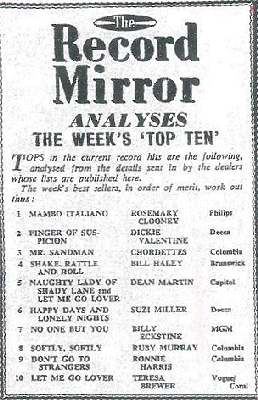 |
 
|
The NME chart is suspected of 'hyping' charts when a member of their staff is found to be involved in manipulations resulting in Bob Dylan recordings entering their chart at much higher ratings than others Thursday 21st January - The first part of a unique chart occurrence happens when the first of two chart entries titled 'Everybody Knows' by The Dave Clark Five entered the chart (the other one first charting on 1st November 1967). Both records were by the same artists and had the same title but were completely different songs May - Music Echo and Mersey Beat publish the first Top 50 LP chart American 'Billboard' magazine (scanned) for 30th October 1965 Saturday 6th November - Pop Weekly reduces its chart to a Top 10 Saturday 27th November - Pop Weekly publishes its last 'sales' chart, continuing to feature a 'readers popularity' Top 20 until its last issue on 12th February 1966 Radio Caroline start using their own 'Countdown of Sound' Top 40 chart Radio Luxembourg start to use a slightly modified NME chart on Saturdays, hosted by Barry Alldis April - Record Retailer increases its album chart to a Top 30 Saturday 23rd April - The publication Mersey Beat (which also ran its own chart) is incorporated into Disc which becomes the Disc and Music Echo, increasing its singles chart to include the Top 50 although Mersey Beat had previously published a Top 100. The renamed paper also starts publishing a Top 10 album chart, removing LP sales figures from its singles chart Friday 2nd December - Record Retailer increases its album chart to a Top 40 Friday 23rd December - 'Ready Steady Go! finishes Radio Luxembourg change their chart to a more airplay-related one in a show hosted by Paul Burnett Thursday 26th January - 'Release Me' by Engelbert Humperdinck entered the charts, becoming the record with the longest number of continuous weeks in the UK Top 50 chart with a presence lasting 56 continuous weeks Saturday 1st April - Although a Top 50 is compiled, Melody Maker and 'Disc' (both owned by Spotlight publications) only publish their Top 30 in a bid to prevent the increasing practice of 'chart-rigging' at known sales outlets. This makes it more difficult to see which of the lower entries should be concentrated on and meant a far bigger outlay by 'fixers' to push particular records into the visible Top 30 Thursday 25th May - Top Pops publishes its first chart, a Top 30 based on sales returns from about 12 W.H. Smith outlets Thursday 22nd June - Top Pops becomes a weekly publication with weekly charts July - Record Retailer changes its publication date from Thursdays to Wednesdays causing some confusion with its chart statistic returns from outlets Saturday 26th August - The Disc and Music Echo ceases using its own charts and uses a chart combined with that of Melody Maker, using a sample pool of 280 outlets. NME are now using 200 and Record Retailer are still using 85. This placed EMI's 'combined' chart with a sample pool of over 600 outlets, comprising Melody Maker 48%, NME 40%, Disc & Music Echo 6% and Record Retailer 6% |
|
|
All
Original Material Copyright SixtiesCity
Other individual owner copyrights may apply to Photographic Images |